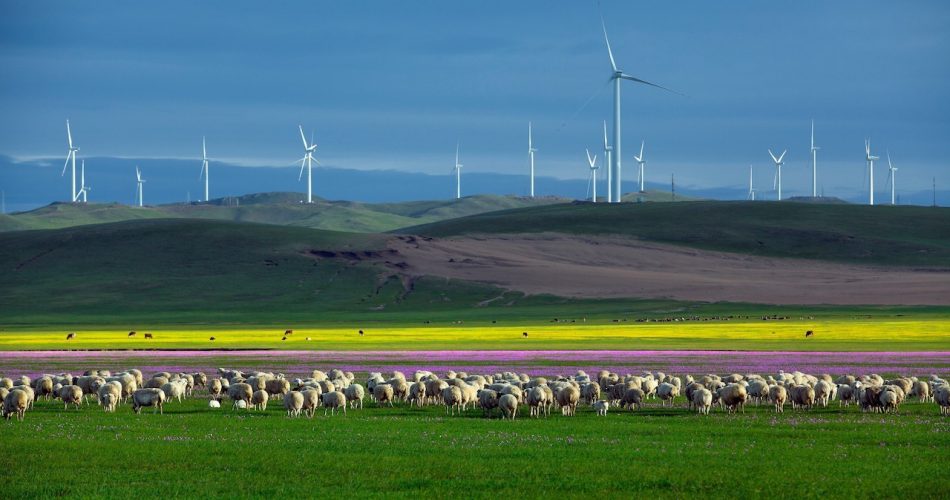Inner Mongolia has the largest grassland pastoral area in China, with a vast area covering plateaus, mountains, hills, plains, deserts, rivers, lakes, and other landscapes, spanning the four major water systems of the Yellow River, the Ergun River, the Nenjiang River, and the Xiliao River.
With the vast Hulunbeier Prairie, the boundless Kubuzi Desert, and the historic Inner Mongolia Museum, Inner Mongolia is a great place to visit.
Inner Mongolia Autonomous Region is abbreviated as “Inner Mongolia”, with Hohhot as its capital. It shares borders with Mongolia and Russia and is rich in steppe culture, forest scenery, and other tourist resources. Below are 10 great tourist attractions in Inner Mongolia.
Top 10 Sights in Inner Mongolia
- 1. Hulun Buir Prairie
- 2. Xilin Gol Grassland
- 3. Arshan National Forest Park
- 4. Ejina Populus Euphratica Forest Tourist Area
- 5. Manzhouli Taowa Scenic Area
- 6. Manchuria National Gate Scenic Area
- 7. Hulun Lake
- 8. Kubuqi Desert
- 9. Inner Mongolia Museum
- 10. Dazhao Temple
1. Hulun Buir Prairie
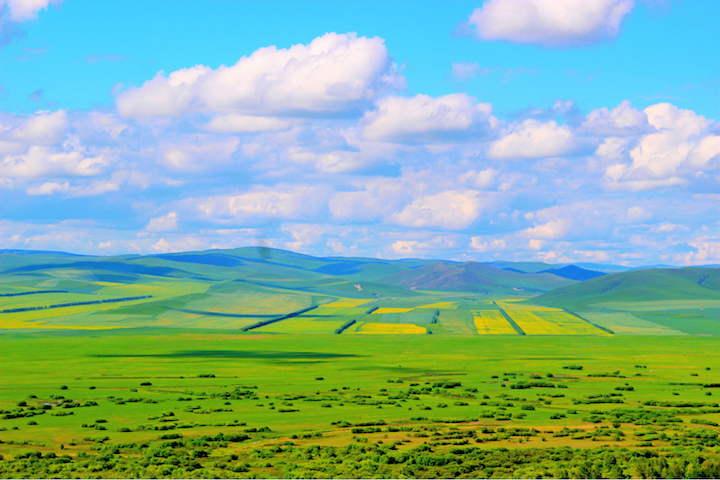
Known as “the cradle of nomadic herdsmen in the northern part of China” by historians, Hulun Buir Prairie is one of the world’s four major grasslands, the world-famous natural pastures, and one of the top twenty scenic spots of China’s tourism.
Located in the west of Hulunbeier City and named after the prairie on the Hulun Lake and Lake Belle, Hulun Buir Prairie is a beautiful scenery, a pleasant place, and was praised as “northern jasper” and “a paradise on earth”.
Hulunbeier is a green pure land and paradise that is rarely seen on the earth, with unlimited scenery in all seasons and numerous beautiful scenes that make people forget to come back.
Especially in July and August, the horseback riding, fishing, or canoeing on the western side of Lake Hulun full of green grass, make Hulunbeier more enjoyable.
Address: Hulunbeier Xinbalhuzuo Banner Haiman Level 1 Highway
Opening hours: All day
Travel taboos:
- 1. When you enter the yurt, you should walk from the left side of the fireplace and sit on the west and north sides of the yurt, and try not to sit on the east side, which is the host’s living room;
- 2. If there is an elderly person in the host’s house, you should not walk in front of him or her, do not sit side by side with an elderly person without permission, and do not block the figure of Buddha lined up on the north side when you are seated;
- 3. When the host offers tea, he should straighten his sleeves and receive it with both hands or with his right hand, not with his left hand.
- 4. When the master makes a toast, he receives the wine and dips his ring finger in the wine to the gods of heaven, earth, and fire, and dips his lips in the wine even if he does not know how to drink, indicating that he has accepted the master’s pure friendship;
- 5. If there is a fire in front of the door or a sign such as a red cloth hanging in front of the door, it means that there is a sick person or a woman in labor in the house, and people are not permitted to enter the house.
- 6. Guests are not allowed to sit on the “west Kang” (a heatable brick bed) because the west is the direction for offering to the Buddha.
2. Xilin Gol Grassland
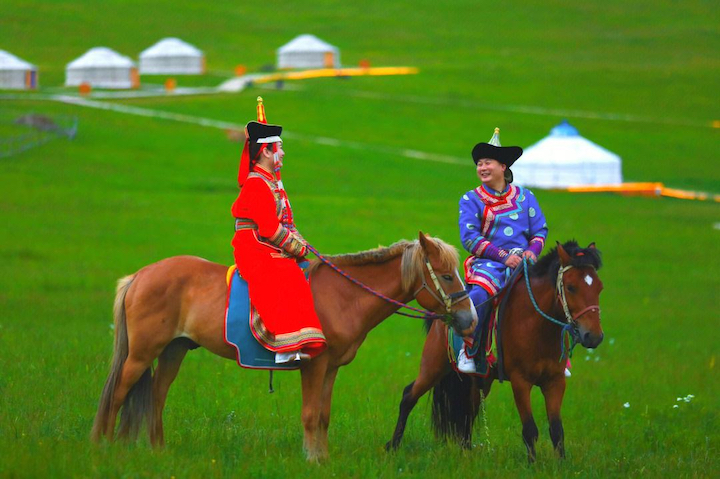
Rated as one of the six most beautiful grasslands in China, Xilingol Grassland is one of the four major grasslands in China and a national grassland nature reserve.
Covering an area of 179,600 square kilometers, Xilingol Grassland has beautiful natural scenery of grassland, ancient and simple Mongolian charm, unique production and lifestyle, numerous cultural relics and monuments, time-honored history and culture, and a pleasant summer climate.
Besides beautiful grassland scenery, there is also the Ancient Great Wall that runs through the middle of the grassland and the world-famous Yuan Shangdu Ruins.
Xilingol Grassland is also home to elegant and solemn rock paintings of Honggeer and the Xuanshi slope and Lima peak found during the Ming Chengzu’s five northern expeditions. There are also attractions such as the world-famous “home of the dinosaurs”, the Tungur Basin.
- Admission: Free
- Recommended travel season: from May to September
- Recommended travel time: 2-3 days
3. Arshan National Forest Park
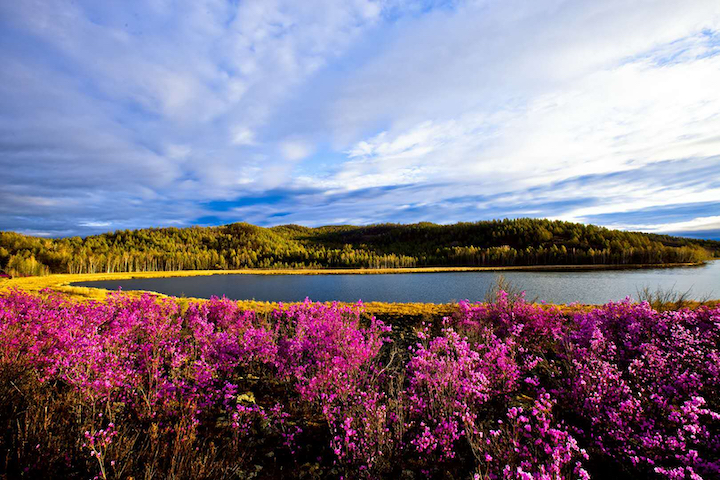
Arshan National Forest Park is a national 5A-level tourist attraction and has been awarded honorary titles such as “Most Influential Forest Park Nationwide”, “China’s Most Beautiful Forest Tourism Scenic Area”, and “National Ecological Tourism Demonstration Zone”.
Arshan National Forest Park is located in the forest sea of the Greater Khingan.
The park has the main peak of the Greater Khingan – Mount Terme (1378 meters above sea level) and the larger lake of the Greater Khingan – Darbin Lake, as well as the Shitang Forest and Tianchi formed by lava flowing during the volcanic eruption. Its mineral water resources are exclusive and renowned as the “Wonderful Spring in the World”.
The Natural landscape of Aershan National Forest Park includes Tianchi Lake, Shitang Forest, Azalea Lake, Rose Peak, Zhangsong Ridge, Khalkhyn Gol, ice and snow, and grassland scenery; its cultural landscapes include old airports, train stations, Japanese puppet fortifications and war sites, and border ports.
It is safe to say that it is a tourist area integrating hot springs, grassland, forests, lakes, ice and snow, wild animals, and plants.
- Address: Arxan National Forest Park, Hinggan League, Inner Mongolia
- Opening Hours: From 08:00 to 17:00 throughout the year; some scenic spots in the forest park will be closed in winter
- Admission: 180 RMB/person in peak season and 150 RMB/person in off-season
4. Ejina Populus Euphratica Forest Tourist Area

The Ejina Populus euphratica Forest Tourist Area is a national nature reserve and one of the main distribution areas of natural Populus euphratica forests in China. It has been selected as one of the top 15 “weather climate landscape viewing areas” in China.
Ejina Populus euphratica Forest is a scenic spot with magnificent natural scenery and captivating autumn scenery, making it a great place to enjoy autumn.
Among them, the most famous one is the Populus euphratica forest, which is known for its “immortality for three thousand years, immortality for three thousand years after death, and immortality for three thousand years after collapse”.
The Ejina Populus euphratica Forest was once famous for the battle between Maggie Cheung and Zhang Ziyi in the woods in Zhang Yimou‘s film Hero, and now it has attracted countless tourists from all over the country.
- Address: Dalaihub Town, Ejin Banner, Alxa League, Inner Mongolia
- Opening hours: 08:30-18:00
- Recommended travel season: from September to October
5. Manzhouli Taowa Scenic Area
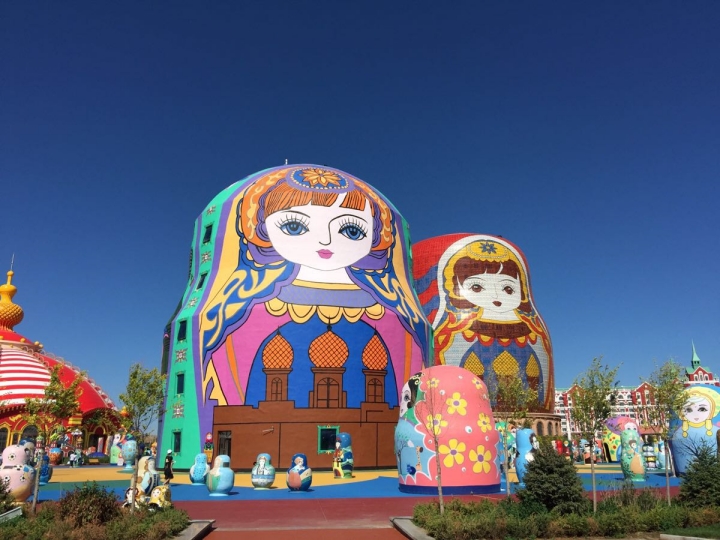
Manzhouli Taowa Scenic Spot is an iconic tourist attraction of Manzhouli City, a national 5A scenic spot, and a large garden of Russian features.
There are six functional areas in the scenic area, including Doll World, Happy Zone, Doll Theater, Russian Folk Experience Hall, Russian Mongolian Performing Arts Theater, and Extreme Park. There are world-renowned Russian Circus, Dream Ballet, and Russian Crafts.
At the Manzhouli Taowa Scenic Area, tourists can enjoy various sizes of dolls and learn about their history and cultural backgrounds. Visitors can also visit the Folk Experience Hall, watch the performances of the Russian and Mongolian Performing Arts Theater, and enjoy the exciting projects of the Extreme Park.
- Address: No. 23, Huabu Street, Manzhouli, Hulunbuir
- Opening hours: 09:00-22:00 throughout the year
- Admission: 148 yuan/per adult
6. Manchuria National Gate Scenic Area

Manzhouli National Gate Scenic Spot is a national 5A level scenic spot, a national key Red tourism scenic spot, and also an important part of the Sino-Russian border tourist area. Manzhouli is titled one of the “China’s Excellent Tourist Cities”.
The scenic spot includes the National Gate, No. 41 Boundary Monument, Red Tourism Exhibition Hall, six major exhibition halls of the Communist Party of China, the Manchuria Red Secret Traffic Line Site, and other landscapes.
Among them, the fifth-generation national gate is equivalent to the Russian national gate, which is a milky white building with a height of 30 meters and a width of 40 meters.
The six major exhibition halls of the Communist Party of China (CPC) are two-story Russian buildings. Inside is the Red Tourism Exhibition Hall, which was rebuilt and expanded from the original Sino-Soviet meeting room, with the theme of “carrying forward the red history and inheriting the revolutionary spirit”.
- Address: Wudao Street, Manzhouli City, Hulunbeier, Inner Mongolia
- Opening Hours: 09:00-17:30 throughout the year
- Admission: 70 RMB/person
- Recommended duration of play: 1-2 hours
- Suitable travel season: suitable for all seasons
7. Hulun Lake
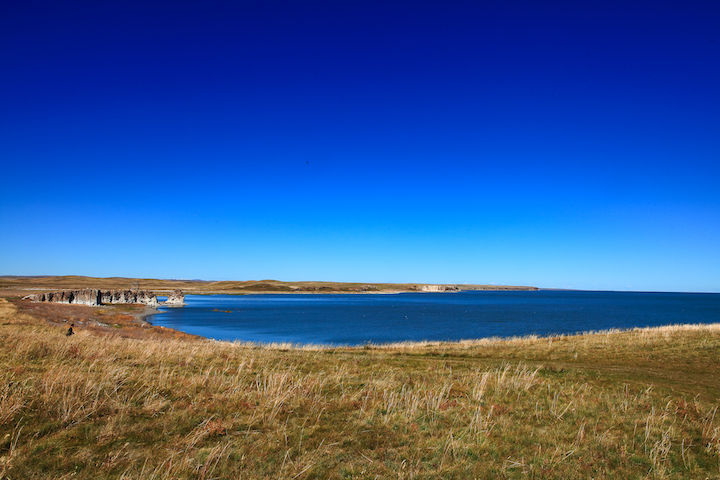
Known as the “Pearl of Grassland” and “Kidney of Grassland”, Hulun Lake is one of the five largest freshwater lakes in China and the largest lake in Inner Mongolia.
Hulun Lake is also called Dalai Lake. “Dalai” is in the Mongolian language, which means “a lake like a sea”.
There are 8 famous scenic spots in Hulun Lake, namely, “Sunrise on Water”, “Mirage in the Lake”, “Stone Pile Love Horse”, “Jade Beach Surf”, “Tiger Roaring Hulun”, “Elephant Mountain Watching the Moon”, “Reed Marsh Birds”, and “Gull Island Listening to the Piano”.
The Hulun Lake is a perfect summer resort with water and sky, densely-packed reeds, “pillars in the lake” and strange stones such as “tiger mouth” and “Elephant Trunk Hill”.
- Address: Hulunbuir New Barag Right Banner Hulun Lake Tourist Attraction
- Recommended duration of play: 2-4 hours
- Recommended travel season: from July to September
- Admission: 40RMB
- Opening hours: 08:00~18:30
8. Kubuqi Desert
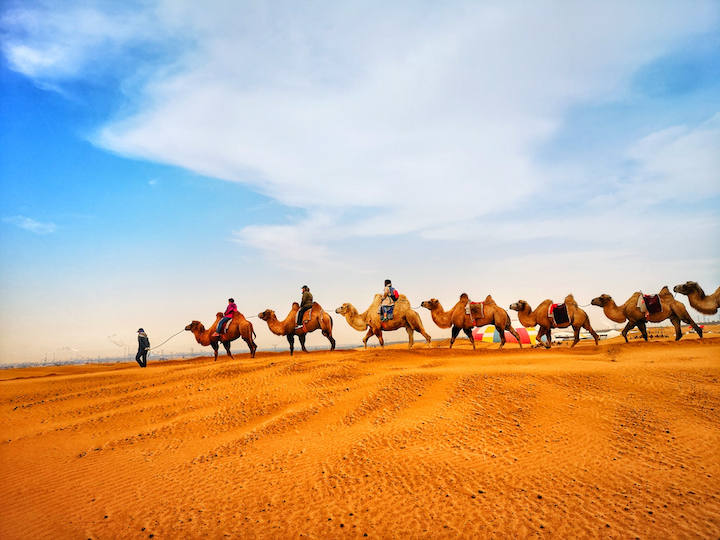
Known as the “oasis in the Chinese desert”, the Kubuqi Desert is the seventh largest desert in China, one of the youngest deserts, and one of the largest active deserts in the world.
“Kubuqi” is a Mongolian word, meaning the string on the bow, because it is under the Yellow River, like a string hanging on the Yellow River. That is why it is named.
The Kubuqi Desert is famous for its magnificent and unique landscape. The main scenic spots are Xiangsha Bay, Qixing Lake, Shenguang Xiangsha, Engebei, Yemingsha, etc.
The picturesque crescent-shaped dune chain, rare ridges of sand, honeycomb-shaped contiguous dunes, and many other desert landscapes are naturally magical, presenting the original desert scenery. For those who enjoy exploring deserts and natural environments, it is a good place to visit.
- Address: Dalad Banner, Ordos City
- Opening hours: all-day
- Recommended travel time: from April to October
9. Inner Mongolia Museum
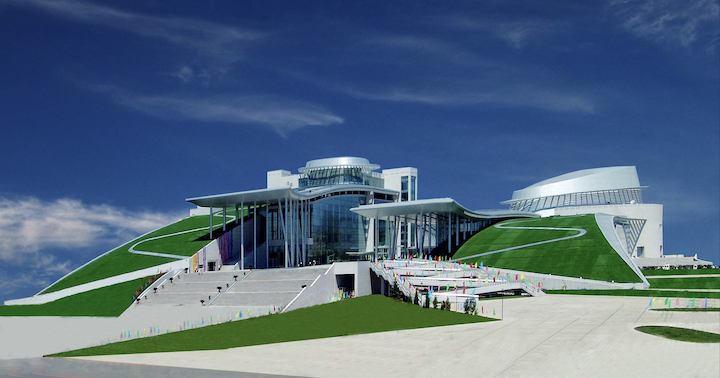
The Inner Mongolia Museum is a national first-class museum and one of the earliest museums in ethnic minority areas in China. It was listed as a remarkable building in the world’s architectural history as early as the 1950s.
The Inner Mongolia Museum is located in the center of Hohhot City.
The buildings of the museum are a collection of modern elements, regional representations, and national characteristics.
On the roof, there are galloping horses, symbolizing the auspiciousness and prosperity of Inner Mongolia.
This building has become one of the iconic buildings in the capital of the autonomous region since its completion.
The Inner Mongolia Museum has a large collection of precious cultural relics and artworks, including ancient cultural relics, ethnic cultural relics, natural heritage, etc.
Starting from the second floor of the museum, the exhibition hall displays the themes of the ancient world, plateau grassland, national culture, historical culture, etc.
This museum is an important channel for domestic and foreign tourists to learn about the history and grassland culture of Inner Mongolia.
- Address: No. 27, Xinhua East Street, New District, Hohhot
- Opening hours: 09:00-17:00 every day except Mondays
- Admission: free
- Recommended duration of the play: 2 hours
10. Dazhao Temple
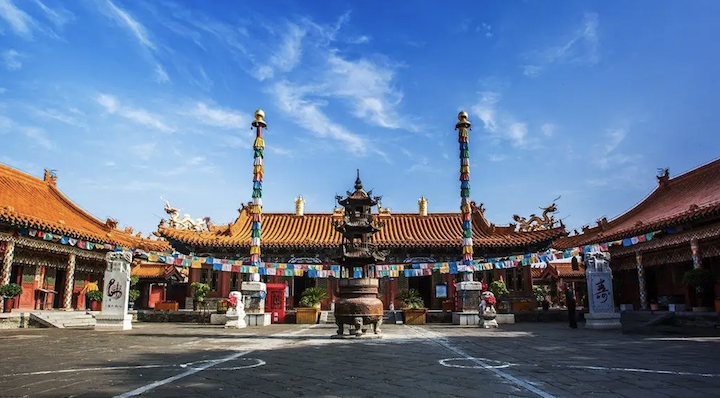
Dazhao Temple is a national 4A-level scenic area and a Buddhist holy land with both domestic and international reputations.
Dazhao Temple is a Tibetan Buddhist temple in the south of Yuquan District, Hohhot, Inner Mongolia. It is a typical temple of the Gelug Sect (Yellow Sect).
The Tibetan word “Zhao” in Dazhao Temple means “temple”, which was later changed to “Wuliang Temple”. As there is a silver Buddha enshrined in the temple, it is also known as “Silver Buddha Temple”.
Its magnificent temple architecture, precious cultural relics, and artworks, as well as mysterious Qiamu dance and Buddhist music, constitute the unique “temple culture” of Dazhao Temple.
- The recommended season for play: from May to August
- Recommended duration of play: 2-3 hours
- Admission: 35RMB/person
- Opening hours: 09:00-17:00
Inner Mongolia is a charming tourist destination with rich natural resources and unique culture. Here, visitors can enjoy the beautiful grasslands, spectacular mountains, and mysterious deserts, as well as the essence of the culture of Mongolia and Buddhist culture. If you want to experience the beauty of nature and the charm of culture, then the top ten must-see attractions in Inner Mongolia should not be missed.
